Entries from September 2010
September 20th, 2010 · 1 Comment
I’ve thought about it, and out of the three plays we’ve seen (or at least the ones we were required to have seen), Habit of the Art, is my favorite. Considering I fell asleep for twenty minutes during the play, I take it to be somewhat of an odd choice. But while the impression I had received afterwards from the other two plays (Merry Wives & 39 Steps) dissipated within hours of viewing, Habit, oddly enough, stuck with me for much longer. No, Habit does not have the seamless grace of dialogue and movement of the Shakespearian comedy, nor the zest and technical splendor of the Hitchcock inspiration. What it does have, however, is a surprisingly powerful – if at a times tedious – meditation on the persistence of making art, making it despite the absence of a theatrical director or the lost prospect of an unremitting future.
I’ve seen very few plays in my life so I’m not able to judge the Alan Bennett piece from a holistic and comparative knowledge of the theatre, but I do know that I liked it, and that it offered something that the other two plays didn’t: the opportunity for thought, that is, a chance to immerse myself into the intricacies of the work, long after its performance. *Deep breath* Merry Wives, forgive me, is WEAK Shakespeare. You won’t find a critic who will champion it before Much Ado About Nothing or Twelfth Night. It does its job though, and that is to give us a good laugh. 39 Steps, while somewhat entertaining, is much too vaudeville, too slapstick for me to take seriously (it was more of a treat listening to Mikey and Carol-Ann trade laughs). As a parody on the film of the same name, however, the play does its job in replacing suspense with comedy. But I do not like Habit because it is the seemingly least funniest of the two. (For the record, I think Wood Allen’s prose should have won him a Pulitzer). I like it because the play’s reflections on art and mortality, and ambition and creativity is invariably more interesting than seeing Falstaff duped by faeries (okay, I won’t go that far, but you take the point). Its a play that makes you think about yourself and the act of creation, whether it be some poetry you write on a napkin in a cafe or the 18 inch mural you have to complete by Friday. Someone wrote that the play was too “high-minded.” I fail to see how. What is so pretentious about a group of actors trying to get through a day’s rehearsal?
Habit, did not blow my mind by any measure. I disliked it upon viewing. But as I’ve been explaining, the play lingered with me, and eventually I came around. Much of the humor I did not understand, but that was most likely because of a cultural rift than anything else (as laughter from the native British folk was prevalent during the duration of the play). Yet the innovative, self-reflexive narrative intrigued me, and did much to compensate for the static mise en scene. I see myself watching it again – later, when I’ve the chance to read more Auden.
All in all, I’ve enjoyed the theatre I’ve experienced in London so far. In Korea, theatre culture is largely concentrated in one district of Seoul, a spot that specializes in more contemporary and avant-garde productions. Although you can catch traditional folk plays in the more rustic cities, as far as modern plays go, the options aren’t so many. What compounds the problem of availability is attendance – a relatively low number of people frequent the theatre (Koreans see more movies, and although that may be the case for just about any other country, Korea has the distinction of being one of the few countries that makes more money off of its domestic films than foreign ones, a fact that is even more compelling when you consider that the screen quota is much skewed in favor of imported films). Just the sheer number of programs that are billed here in London is a reminder that there is a population that demands them. I’ve noticed that many people in the gray and distinguished demographic visit the theatre, at least judging from the three that I’ve gone. Considering that Habit deals with homosexuality so frankly, it is somewhat of a surprise to me that many elderly were in attendance. Maybe the seniors in this country are less conservative, less puritanical than in America? I’ve also seen plenty of children and teenagers at these events as well. Not to mention the vast number of students our age and men and women in their thirties and forties. The diverse population of theatre-goers is a testament to the strong cultural tradition in this city. Perhaps its time for other cities to follow suit.
Tags: 2010 Sean · Theatre
September 20th, 2010 · 1 Comment
I’m a slow museum goer. I like to read all of the text as I go through, and when at an art museum, I tend to find a few paintings to focus on for, say fifteen minutes each, looking closely, and then backing up again, trying to discover the secret to the artist’s technique in the brushstrokes. And so I’ve found the process of visiting museums in London frustrating for the same reason that I’ve thoroughly enjoyed the experience: the collections at most of the museums I have visited here are just too expansive to see everything in a single afternoon.
The most extreme example is the Victoria and Albert Museum: each room is overwhelmingly full of objects, and almost every object is accompanied by a full paragraph of text. So fairly early in my visit there, I abandoned trying to read everything and even walked through some rooms without stopping, in order to use my time to really get a sense of the full extent of the museum. Not surprisingly, I really enjoyed the few exhibits were simpler, less cluttered, and more focused, such as the sequence of Peter Rabbit illustrations (which was a fun surprise). However, among the clutter I also stumbled on some amazing contemporary pottery within the Japanese exhibit, simply because it happened to catch my eye. In an entirely different part of the museum I saw some oil sketches by John Constable that looked surprisingly impressionist, compared to his typical, more realistic, complete landscape paintings. Over all, I was able to see plenty that I found interesting, despite skipping items and full exhibits along the way. However, the experience was somewhat stressful, since I knew that I had so little time to see so much.
In some of the art museums that showed mostly paintings I ended up needing to skim the collections as well. On my first visit to the National Gallery, I ended up looking at only the rooms that featured impressionist and post impressionist paintings since I love looking at paintings by these particular artists, and therefore spent a lot of time in front of each individual painting. (I discovered a new favorite Van Gogh painting, and a photo of it is attached to this post.) When I went back about a week later to see the rest of the museum, I still had to skip a lot of paintings and captions in order to get through see a variety. The skimming process inevitably led me to focus on finding the more famous paintings, such as Van Eyke’s Arnolfini Wedding Portrait and Hogarth’s Marriage A La Mode series, and although these were not all that I looked at, I wish I could have spent time looking at more of what the museum had to offer. It’s a strange trade off to be in a museum with a lot of amazing art, but to not get to see all of it because of the sheer quantity and quality throughout. My experience in the Tate Britain was similar, though to a lesser extent: there was an entire wing devoted to Turner paintings, many of which were truly breathtaking to look at, and I found it difficult to decide how to ration my time in order to move on to other parts of the museum.

Van Gogh painting (photo from National Gallery website)

Turner Painting (from Tate website)


The Sir John Soane Museum was an exception because it was much smaller than the other museums that I visited and included very little text. However, I had little access to information about what I was seeing, so I left feeling much less satisfied than when I left the larger museums. I definitely prefer a museum having too much on display that I want to see, rather than not enough. I still cannot figure out whether most museums in London are more text heavy than those in the States, or whether I just read very little of it here simply because there is so much to see. Either way, I think that I could return to a few of the museums that I visited every day for a week, and still have more left to discover there.
Tags: 2010 Emily · Uncategorized
September 20th, 2010 · 1 Comment
The Royal Crescent, located on the outskirts of the town of Bath, is an excellent example of the Georgian style of architecture common in housing built during the 18th century. Designed by John Wood the Younger, the Crescent is similar to much of the architecture in Bloomsbury is that the windows become shorter as you move further up the building. Another Georgian feature are the the Ionic columns between each of the windows, throughout the facade.
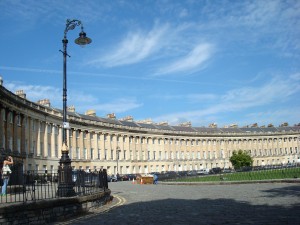
The Royal Crescent was built between 1767 and 1774, and was formerly home to British royalty such as Prince Fredrick, Duke of York and Albany. Unfortunately, the Crescent sustained some damage during the World War II bombing raids, as the Ministry of Defense is not located far from Bath. However, this damage is not apparent to the splendid condition that the building is currently in.
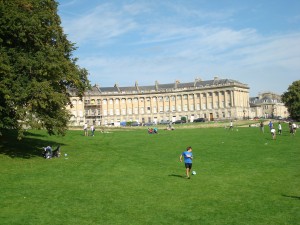
One of the most breathtaking views of the Crescent is looking upward from the bottom of the hill, looking past the expansive park above. There was a game of pick up football happening on the far side of the field, and closer to the Crescent park goers were sunbathing and picnicking.
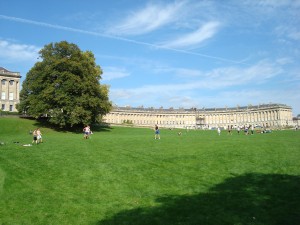
Bath was by far the most scenic town I have ever been to, and I found it hard to put my camera down considering how aesthetically pleasing the sights were.


Tags: 2010 Tyler · Uncategorized
September 20th, 2010 · 1 Comment
Rather than spend another post discussing curating practices or the pros and cons of government subsidies for museums, I wanted to write about the behavior I’ve observed in visitors to museums because, as a psychology major, this is what interests me. First, one can definitely tell the difference between English visitors to museums and tourists visiting museums. Tourists walk around looking up or looking sideways, gawking and paying no particular attention to where they are going. There was woman in the Map exhibit in the British Library yesterday who was wheeling around a suitcase behind her as she went through. Madam really, you are currently taking up enough space for three people. This doesn’t surprise me much, as I’m used to tourists in America being clueless and gawking as well. What I find more fascinating is the behavior of British visitors.
First, English visitors seem to come to museums with a specific purpose in mind. They seem to know exactly what they want to see and exactly what they want to learn or get out of their trip and proceed to the appropriate location efficiently. I’ll admit that it’s true that British visitors, especially Londoners, are at a bit more leisure to do this, since they live here and can return as often as they like while we tourists need to cram in as much as possible in a short period of time. In addition, some of these people are students with notebooks who must be on assignments concerning a certain painting or exhibit. An interesting mission that I’ve seen English museum visitors pursuing is educating a child. I’ve seen this several times, but I’ll share the example of a mother and son that I saw in the National Portrait Gallery. The mother had a notebook and was trying to convince the son (who seemed about 4 or 6 years old) to choose a picture he liked and try to draw it to “show Daddy later.” The son was reluctant and threw a few fits (as big of a fit as an English child would throw) but the mother was very persistent and kept telling her son, “We’ll look at just one more, one more picture.” When I saw them again later on, the son seemed a bit more engaged, but I just thought it was interesting that parents would bring their children to museums with such a structured purpose.
The second behavior that I’ve observed seems to relate to the English privacy rules and the social dis-ease mentioned by Kate Fox. I’ve noticed that if an English person is looking in a case or at a sign, and I walk up next to them to look at the same object, they will either apologize and leave, or give an embarrassed smile and leave. I still don’t really understand what they are apologizing for, but it’s almost like they think more than one person cannot occupy the same object (or 3 foot radius) as another person, like each person needs their time alone with whatever sign they are reading. I remember looking in the Museum of London at the Docklands at the hanging bird cage thing in which they would put pirates for birds to come eat them and a small child ran in front of me, pressing his nose on the glass, and asking his father to come look. The case was rather large, the print on the sign rather large, and the child rather short. He was not obstructing my view at all, but the father scolded him “Don’t stand there; the lady is trying to look.” I protested and said something like “Oh don’t worry he’s fine” to which the father gave an embarrassed laugh and quickly walked away. This behavior seems strange, awkward, and overly polite, but it makes some sense when we apply what we’ve read in Fox, and in light of other examples of social dis-ease that we’ve experienced in England. I suppose I prefer it to the behavior of American tourists, who will actually obstruct your view of something, and run you over with a suitcase while they’re at it.
Tags: 2010 Kaitlin
September 20th, 2010 · 1 Comment
I used to think that William Wordsworth was kind of a sap, always going on about daisies in a field and all that in his poetry, but since arriving in London, I’ve come to respect his stance a lot more. I still think that Wordsworth is a bit melodramatic, but I understand his need to remember images from nature. I grew up in rural Connecticut, so I’m used to seeing cows, fields, and woods all on my two-minute drive to the center of town. Before this program, I had not spent more than three consecutive days in a city, and I can honestly say that the parks have kept me sane. London is a wonderfully dynamic city, but it’s also exhausting, and I think that the parks here are an absolute necessity for the people who live here.
London, like any major city, is loud, chaotic, fast-paced, and extremely crowded. Walking down Tottenham Court Road is an exercise in agility. Weaving through people all of the time, especially tourists who stop short to take photographs or consult maps, can become extremely frustrating. But inside of the parks, the bustle of the city seems much farther away. In Queen Mary’s Garden at Regent’s Park today, I was almost able to forget that Marylebone Road ran just outside of the gates. It’s quiet, and you can actually hear the sounds of nature. Although some parks undeniably attract more tourists than others, I saw people just laying on the grass sleeping, reading, doing absolutely nothing at all, in all of the parks that I visited. I think that people are just so relieved to be out of the insanity that is London’s streets that they can’t resist the opportunity to sit down and enjoy a quiet moment.
This is reflected in the development of the parks, as well. Regent’s Park and St. James Park were both made into hunting grounds by King Henry VIII, but they’ve become beautiful, public green spaces. Hyde Park and Kensington Gardens really were formed due to necessity; Queen Victoria decided that the public could really use a park to combat the crowded, polluted conditions of a newly industrialized London in the nineteenth century. Wordsworth fell at the beginning of this time–in his day, London was just beginning to become an industrial power, and we can be fairly certain that his description of the city in his poem “Composed Upon Westminster Bridge” were not completely accurate. Wordsworth sought out beauty in nature because he was suffocated by conditions in the city.
Yes, some of the gardens seem a bit contrived (the bridge at St. James Park just happens to offer beautiful, leafy views of both Buckingham Palace and Whitehall), but the English do love gardening. And today in Regent’s Park I saw people ambling slowly through the very well-manicured rose gardens, literally stopping to smell the flowers. Couples were cozied up on benches, people were reading under weeping willow trees, and one gentleman was just conked out in the sun. As I walked down the avenue, I noticed people sunbathing and playing a football match, also a common sight in Hyde Park and Kensington Gardens. No one, regardless of whether or not they were tourists, was in a hurry, and that’s exactly why the parks here in London are so important. People just need an escape from the city for a bit.
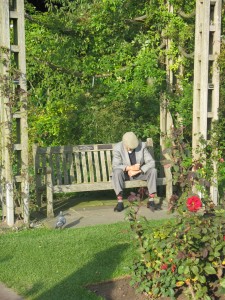

Tags: 2010 Holly
September 20th, 2010 · 2 Comments
Most of you have been writing about the secular nature of churches in England, how they don’t really seem like a spiritual community, and how it is a bit disturbing that all of them come with cafes and gift shops. While I agree with these thoughts, I don’t think that it is necessarily all bad, and I think that we need to consider that we are not seeing the entire picture.
I think that the secularism of the Anglican Church particularly stands out against our visits to the Mandir and the mosque. At these places of worship, people go to pray every day and there are spiritual ceremonies every day as well. They each have schools, child care centers, and service projects that reach out to the community. I can see where we might wonder why we are not seeing the Anglican Church step up to its role as a spiritual and community leader, but remember that we discussed in our first ever class meeting how in these minority communities, religion is very much one and the same with culture, especially in Islam. The difficulties they have assimilating into English culture are due in large part to religion. Religious teachings and traditions have become well ingrained cultural traditions. Anglicanism is a relatively new religion in comparison with Hindu and Islam, and does not play the role of being one and the same with culture like it does in the other communities. And when you are the majority community racially, religiously, politically etc…it doesn’t need to be.

the Mandir, courtesy of it’s website mandir.org
The second point I wanted to make in this post is that Westminster Abbey and St. Paul’s do remember their function as places of worship. I was on the Westminster Abbey tour with the science group. We were there at noon, and at that time an announcement came on that called for a moment of silence. John reminded us that we were in a church, not a museum, and I noticed that nearly everyone visiting the Abbey at that time, tourists included, was respectful of this moment. I also attended Evensong at St. Paul’s and thought that it was a beautiful and moving experience. I think that they balance their two roles as best as they can, and hey, if my church had a café, I would use it. Speaking of places of worship that balance spirituality and tourism, look at Vatican City. No one can argue that this is not a deeply meaningful and spiritual place; Catholics journey from miles around to hear the Pope speak on Christmas, or at any other time of the year really, but it is also a huge attraction, complete with guided tours through St. Peters and rampant pick pocketing.
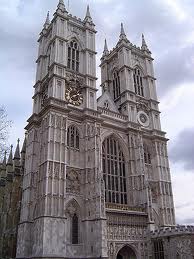
photo credit: Google Images

photo credit: Google Images. All of these buildings were too big and beautiful for me to take a good picture of them myself.
Finally, the fact remains that we have not been to any small Anglican parishes in specific residential neighborhoods of London. I’m sure that there are religious Anglicans in London who do go to church every Sunday and whose churches run community service projects and functions, but, similar to your local church at home, which also attracts no visitors, these churches probably don’t have history such as the Battle of Hastings and the Great Fire of London surrounding them. We definitely are not seeing the whole picture here, which is why I cannot join in lamenting and expressing disappointment in places like Westminster Abbey or St. Paul’s, or the Anglican Church in general.
Tags: 2010 Kaitlin
September 20th, 2010 · No Comments
The Victoria and Albert Museum in South Kensington is unique in that instead of focusing on one style or type of art, the exhibits at the Victoria and Albert include diverse forms of decoration. I use the term decoration broadly because the museum is essentially a collection of decorative items and artifacts, including porcelain, tapestry, and other furnishings, mostly from the 16th century onward. Also featured are exhibits on sculpture, but that is for another blog.
The museum bills itself as “the greatest museum of art and design”, and in that respect it fulfills its mission. It would be overly simplistic to say that the Victoria and Albert is simply a collection of the conspicuous consumption of the well heeled before the 20th century, but not completely off the mark. The luxurious possessions which comprised the museum included silver and gold gilded tea sets, large tapestries, and detailed porcelain. For example, there was an exhibit on Chinoiserie, which despite its name, was not specifically a Chinese craft. In fact, Chinoserie was a combination of Japanese, Chinese, and Indian motifs designed and produced in Britain in the mid 18th century.
A section which interested me in particular was the exhibit containing artwork and artifacts involving Johnathan Tyers, an ambitious entreprenuer from the 18th century. Tyers really loved George Friedrich Handel, so much that he commissioned a statue of him for placement in Spring Gardens near Vauxhall.
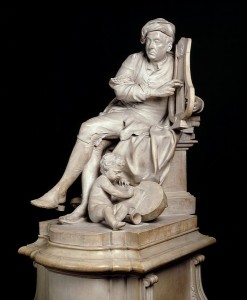
Taken from (http://collections.vam.ac.uk/item/O34256/statue-handel/), by Louis Francois Roubiliac.
This statue features the composer playing the lyre of Orpheus, a mythical figure whose music calmed even the most savage beast. Tyers wanted this statue to be placed in the heart of the Gardens, possibly as symbolism of his campaign to convert the gardens from its earlier seediness. Today, I stopped by the gardens, a five minute walk from the Vauxhaul station on the Victoria line, hoping to see the product of Tyers’ toils. But unfortunately the previous gardens had been razed in order to build housing, and when that housing had been demolished the gardens were not restored to their previous glory. The park had clearly reverted to its seedier nature, judging by the sight of a homeless man passed out on a park bench holding a bottle of whisky…
Tags: 2010 Tyler · Museums · Uncategorized
September 20th, 2010 · 1 Comment
This afternoon myself and a friend visited Regent’s Park to have a bit of footy in the sunlight. The day was beautiful, and the park was breathtaking. Being my first visit to Regent’s Park, I can honestly say I could have spent days there. The major difference between Regent’s Parl from the other park that I have spent the most time in, St. James Park, was the awesome, gigantic field space used for sporting activites or “ball games”. We spent time in both the large, sport dominated field area as well as the walking route among the gardens and fountains of Regent’s Park (I would have several lovely pictures for you all of our leisurely day, but sadly I left my camera in the hotel upon departure). In comparing Regent’s Park to St. James Park there are a few key differences.

(Regent's Park)
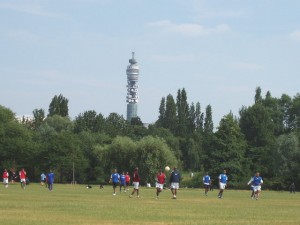
(Sporting Area of Regent's Park)
Regent’s is divided into two sections, the “ball games” field section and the walking route (which has a few little subsections). St. James only has the walking route. Both are beautiful, St. James seemed a little bit more open in the strolling section, and had a little more to offer visually in terms of natural elements (it’s on that fantastic lake and has all those birds running around, it’s hard to beat the pelicans). It seemed like perhaps more manmade work had been done in Regent’s however, the section that we strolled through had several beautiful fountains and well placed gardens, giving it a very tranquil and calm feeling (not as many people either). I could go on for days about how beautiful and elegant these parks were, but I want to discuss what their purpose actually is in British society.

(St. James Park)
The Brits put a lot of pride in three things: museums, churches, and PARKS. These parks all have had one or more notorious architects working on their designs and perfecting them over centuries. They are signature landmarks of the UK, world famous Brits and royalty have worked through them over hundreds of years. Why? Like I said in my blog about the purpose of pubs in British society, it seems like when the Brits aren’t living the hustle and bustle lifestyle of London, in packed tube cars and crowded streets, they like to take a minute to value their time with others and the so called “simple things” rather than spend their time playing watching television or on their computers, like Americans. The Brits are generally doing one of the following things during their visit to the park: walking their dog, chatting with a friend, having a picnic, kicking around the old football, or just having a stroll. All simple, leisurely activities that you don’t need to pay a cover charge for. These parks have so much money and effort poured into them because most of the population of the UK treat them as a national treasure and use them so much. They are a significant part of the history of England. Cheers.
Photos courtesy of: londonrelocationservices.com, yourlocalweb.co.uk, earth-photography.com
Tags: 2010 Benjamin
September 20th, 2010 · 1 Comment
I am not a big theatre guy, but every Christmas (before they decided to take us to operas instead) my grandparents took my brothers and me to see a Broadway musical. I always enjoyed dressing fancy and taking the train into New York City. I loved walking into the theatre and finding my seat. The load commotion of the audience thrilled me and when the lights started to dim, that’s when I realized what where I was and what I was doing.
The theatre we went to here, however, was so different than what I would experience every winter with my family. I know that the shows we went to were not supposed to be exactly like Broadway, but that’s what I have been accustomed to. I’m used to dancers, lots of extras, enormous props and flashy lights. It’s like what Rick Fisher explained to the group during our first class discussion. Plays are different here in London, they aren’t as glamorous or glitzy. Of course, I didn’t go independently to any plays or musicals, so I can only agree with this based off what I have seen here.
The Marry Wives of Windsor, the first production we saw, was unbelievable. Being inside the Globe Theatre was an experience within itself. We stood just as the groundlings did in Shakespearian times (however we were required to be a little more well mannered). My legs did get tired, but for the most part the performance distracted me. From only reading Shakespeare, I don’t get the nuances and I miss most of the meaning because the language and humor is not what I am used to. But the actors and actresses were able to present so that I actually understood what was going on! It was truly a hilarious play. Although we saw the play at night with lights brightening the stage, and we were able to buy Cokes from a vendor in the audience, I really think I at least got a glance at what it would have been like to see the production when it originally was performed.
Another hilarious show was The 39 Steps, the play adapted from the Alfred Hitchcock film that we saw at The Criterion Theatre. This four-man show was brilliant. It was the most Broadway-like production we saw in London, but really only because of the atmosphere. I didn’t notice until Chris pointed it out, but the play was extremely British. It was most apart in the apologies that the characters would give through out the play. “Sorry” for everything. I enjoyed watching the characters use props in three or for different ways. Chairs became cars and dressers became fireplaces.
I am still unsure about the final visit we had to the theatre, where we saw The Habit of Art. Not only was I a little distracted by Sir Ian McKellen, but my attention began to wane during the transitions between the play we were watching and the play inside the play we were watching (huh?). I heard many classmates say that they would have rather just seen a play about the poet. I got annoyed by the interruptions by the actors, because sometimes I forgot that the play I was watching was not just a play about the poet.
Our tour through the National Theatre was interesting and I really learned a lot about how unique the productions there are. Unlike West End theatres, the National Theatre is not just about making money. The facilities there were awesome, and the fact that almost everything is done on sight (from the making of the props to the making of the costumes) is astonishing. This was my favorite part about being at the National Theatre.
All of the experiences at the theatre were worth it. Though I still believe I am not a big theatre guy, I really enjoyed everything I saw.
Tags: 2010 David · Uncategorized
September 20th, 2010 · No Comments
That’s what every city in the world should be, because they don’t have as much green as London does. No, I don’t mean money, I mean real green, in the form of parks.
As I write this, I am sitting in my favorite of London’s parks, Regent’s Park. In fact, I didn’t realize that it was my favorite until I ventured here, knowing that I needed to write about parks and wanting to get away from the city for a while without going far from the Arran House. After consulting my A to Z, I found that we’ve been living for a month not 15 minutes away from one of London’s most beautiful parks, which is saying something, because London has some wonderful ones. Of these, I have visited three, and they are probably London’s most famous: Regent’s, Hyde, and St. James.
I’ll start with Regent’s. As I said, I came here needing to be somewhere quiet, and most importantly, green. I love the outdoors, and was feeling like I hadn’t gotten enough of them while in London. Regent’s quickly fixed that though. Probably best known for its prominent role in the 101 Dalmatians and James Bond (MI6 is near the Park), Regent’s Park is situated on 410 acres in Marylebone. Its perfectly trimmed flowerbeds, beautiful fountains, and huge open spaces are a breath of fresh air, literally and figuratively. The one thing that really differentiates Regent’s from the other parks I will talk about is the lack of tourists. Regent’s doesn’t have anything particularly special for tourists, as opposed to Hyde and St. James, so it is both less busy and quieter. It also houses the London Zoo (yes, the one that Harry Potter went to in the first book), for any animal lovers out there.

Regent's Park
Next up is Hyde, or specifically Kensington Gardens, which is contiguous with Hyde, and is often thought of as part of the same park (technically its not… I also visited Hyde, and it’s much the same as the Gardens). Like Regent’s, it features wide open spaces, fountains, and gardens. However, it also contains Kensington Palace (which also serves as a shrine to Princess Diana), the world-famous Peter Pan statue, and the Prince Albert Memorial, which all attract a lot of tourists, which increases the “busyness” of the park, and changes its atmosphere. It is still a very nice park, but it just doesn’t have the feel of Regent’s.

Peter Pan Statue in Kensington Gardens
Lastly, St. James Park. Once again, lots of open space, water features, and flowers. The big tourist attractions here completely surround the park, rather than being contained in it. These include, but are not limited to, the Houses of Parliament, Westminster Abbey, and Buckingham Palace. This brings a lot of people to the park which, while not a bad thing, makes it feel crowded, which is not how parks should be in my mind. It is an absolutely beautiful park though, despite its well-publisized history of, well, err… you know. For those that don’t, Edward II had dozens of children, none with his wife, and loved spending time in the park. I’ll let you do the math.
To wrap up, I’d like to mention that London’s parks have really cool birds. At Kensington and St. James, there are tons of brown geese and small little birds, pictures of which I’ve attached below. At Regent’s though, they seem to have completely different breeds of birds, which you can also see below. St. James also has pelicans, which I unfortunately don’t have pictures of.
I have no idea why the birds would be so different between one park and another, unless these birds were purposefully introduced to their respective parks, which would be a conclusion requiring an understanding of London parks history that I lack. Anyone with more insight, please feel free to chime in.

Bird characteristic of the populations found at Regent's Park

Swan, characteristic of the bird populations at Kensington Gardens and St. James Park
Tags: 2010 MatthewM






















